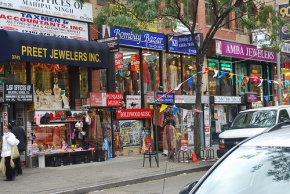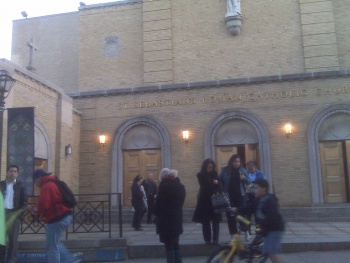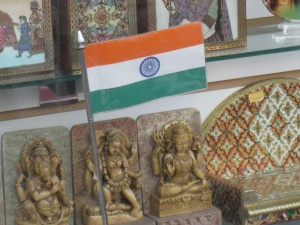From The Peopling of New York City
Inside, Outside and Around Jackson Heights
Religion is a factor of great importance in the lives of South Asians inside the Jackson Heights community, outside Jackson Heights in India and around Jackson Heights in neighboring communities.
Inside Jackson Heights
First, dealing with the people and the demographic of this community, which vary in religion, many interviewees have argued religion does not affect their interpersonal relationships. Specifically, Anthony Rodrick, a Catholic Christian, who described his Hindu best friend. Along with Anthony, his family respects the Hindu gods, plays a Hindu game called “holy” and recognizes “Diwali,” the Hindu New Year as well. He says “over here we tend to work together and help each other out because at the end of the day, we are all Indian and have love for the country. I'm very happy inside when Indians get recognition because then I'm proud of my country so over here we work as a team…” A Jackson Heights resident and store worker, Sachiv, confirmed the non-discriminatory ideology of this South Asian community and his lack of interest in the customers’ religious beliefs. He claims that all customers are the same and he is happy to help everyone equally.
Although this may not have been voiced directly, I sensed some underlying tensions when interviewing Islamic street vendors. When I asked touchy questions, he seemed annoyed and refused to speak openly. However, his attitude made it difficult to tell whether he couldn’t speak English very well, was bothered by my questions or felt the need to be defensive due to constant harassment on the streets. South Asians of a multitude of religions live in close proximity, making it difficult not to bring home a long history of religious and territorial conflict. This Pakistani may be reacting in anger because he is tired of taking the blame for what is happening back in India. The most recent terrorist attack in November 2008 that killed over 163 in the city of Mumbai (capital of India) is just the latest horror following a web of religious riots. The attacks drew a widespread of condemnation especially towards Muslim Pakistanis because the attackers were members of the Pakistan-based militant terrorist organization.
Outside Jackson Heights
Back in India, many of the districts are built as separate religious quadrants making it dangerous for woman to walk the streets of a region with different religious beliefs. Unlike, Jackson Heights, there are constant disputes over religion in neighboring counties of India along with major violent attacks. Since the early 1990’s, a series of continuous attacks known as the Bombay Riots between Muslim and Hindu Indians led to the death of about 900 people. A number of attacks on predominately Christian neighborhoods in India also occurred setting people on fire and burning many children to death. Following the Bombay Riots came the 1993 Bombay Bombings, the Babri Mosque demolition, a number of bomb explosions in sequence and the 2008 Mumbai attacks. As if the September 11 terrorist attacks had not put Muslims in the hot seat, the Mumbai attacks have undeniably raised the temperature on Muslim Pakistanis in Jackson Heights. Yet, regardless of politics no outbreaks in violence have occurred in this community.
Around Jackson Heights
To cope with such tragedies back home, many South Asian Christians attend Church and discuss personal matters with officials. The two main churches around the Jackson Heights community are The Joan of Arc Church on 82nd street and the St. Sebastian Church on 57th street. Parochial Vicar David Fairwhether of the St. Sebastian Church says, “I know it has affected many people’s lives and they are upset about what is happening to their families back in India.” People who face periods of great stress and loneliness find support in faith and worship (Lessinger, 1995). Finding comfort in their religious community strengthens Christian Indians’ connection to the Church despite its location just outside Jackson Heights. “Everyone is invited to God’s church and we keep our church open to everyone” says the parochial vicar. South Asian Christians, specifically Bangladeshis also partake in activities as a part of the cultural group known as Probashi. Jackson Heights resident and parishioner at the St. Sebastian Church explains this non-profit group, which his ancestors founded: “There are a few Catholics in Bangladesh and even fewer living in the US...so this group has been founded to connect all Bengali Christians together. At our last event there were 500 visitors. Almost all of us are related in one form or another and we throw parties during Catholic events like Easter and Christmas.” Religion, holidays, cultural traditions and family ties have played a major role in connecting the lives of South Asians around the neighborhood.
Conflict vs. Cooperation
Conflict
Very little evidence shows major past or current problems within the Jackson heights community over religion. “We don’t really care about religion. We are all Indian people and I don’t see them as Christian, Muslim or whatever…” says Sachiv. When asked if he had heard about or seen any major disputes over religion he robustly answered “No, no, no…never! We don’t fight here because of religion.” Jackson Heights residents Ami Shah and Anthony Rodrick and his family also did not report seeing or hearing about fights in the neighborhood. The South Asian community lives peacefully discovering that they possess more similarities than differences in culture. Despite religious disparity, they all share one very important factor: the English language.
Cooperation
On the contrary to what might have been expected in this diverse community, people of all religions, colors, race, gender, ethnicity, and class can coexist in such a dense area. According to Ami Shah, “People are all the same… I pretty much get along with people of all religions.” Because South Asians in Jackson Heights must cohabitate in this small region, it is easier to combine forces and collaborate than wage war and constantly bicker. “We all have to work together because we live next to each other” says Sachiv. Can you imagine a community in which hatred filled the air and blood flooded the streets? Of course not.
Conclusions
So how does religion factor in to the lives of the people of Jackson Heights? The answer to this question varies from person to person. Of the 71,000 people currently living in Jackson Heights, 48% affiliate with a religion. Some people confide in pastors and church officials when discussing familial matters and conflicts back home, while others do not identify with any specific religion and associate with all of them. According to Ramesh Rodrick, religion is essential because it describes everything that cannot be explained by science or common sense. Nonetheless, does religion affect the overall stability of the neighborhood? It seems that despite the various religious groups in the community, there is more cooperation than conflict. Although there are numerous physical altercations in India over religious disagreement, this is not seen or at least voiced in Jackson Heights due to the freedom of religion in the United States. Hindu, Christian and Muslim Indians share communal space making it less likely they are violent toward each other. Had there been numerous conflicts and tensions, this diverse functioning community would not exist. They live in relative harmony because their commonalities outweigh their differences. I am almost certain that there is a sense of nationalism and pride when is comes to the blending of South Asians in one compact area, yet, tensions are kept at a minimum and underground. Different groups make an attempt to understand one another and rarely do they hear of differences erupting into violence. Many have defined Jackson Heights as an area unified by culture, not separate by religion.
--Yzakiniaeiz 08:04, 11 May 2009 (UTC)





